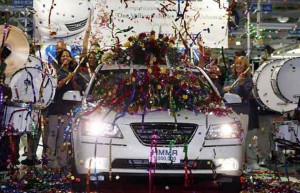With dealers selling new models like the Elantra and Sonata as soon as the trucks roll up to Hyundai’s U.S. showrooms, the Korean carmaker is beginning to ponder the need for a second American assembly plant.
John Krafcik, Hyundai Motor America president and chief executive officer, said the South Korean maker’s U.S. dealers could easily sell more vehicles but are hampered by shortages of Hyundai’s most popular products, including the new subcompact Accent, which has been all but sold out since it went on sales this past summer.
Where dealer inventories typically average 60 days, industry wide, that’s down to barely two weeks, according to Krafcik, a one-time senior Ford engineer, who offered a glimpse at some of the Hyundai products to come during a meeting at the Hyundai-Kia Technical Center near Ann Arbor, Mi.
So far this year, Hyundai’s sales have increased 20% and the company’s share of the U.S. market is nearing 6%, its highest level ever. In addition, the interest of American consumers in the Hyundai brand is steadily rising. A third of American consumers now say they are willing to consider purchasing Hyundai-brand vehicles –double what it with during the middle of the last decade – while the residual value, or resale price, of its vehicles has risen steadily.
If there’s anything that worries Hyundai it’s making sure dealers have enough products to sell, said Krafcik, suggesting “We are looking at the situation very, very carefully.”
However, it could be some time before the South Korean company’s top management, back in Seoul, will be ready to make a decision on adding a second factory in the States.
“If this was the old Hyundai, there is no question, they would be building the second plant,” he said. “But the focus isn’t on volume. It’s on building great cars,” he added. “It’s a long-term strategy.”
In a separate interview with TheDetroitBureau.com, earlier this month, Krafcik stressed that Hyundai management first needs to be sure the brand’s current momentum is sustainable. The last thing they want to do is build a new plant and then get stuck with excess capacity.
Hyundai has had practical experience with that problem. In the 1990s, after first entering the North American market, booming sales led the maker to put up a bland in the Canadian province of Quebec. But a subsequent slump in sales quickly forced the maker to shut that factory down.
For the moment, Krafcik said Hyundai is making adjustment in its Alabama assembly plant so it can build about 10% more vehicles this year than it did in 2011. The toughest challenges have been eliminating bottlenecks in the paint shop.
Even without a new plant, a new study by the Ann Arbor-based Center for Automotive Research estimates Hyundai supports more than 94,000 jobs in the U.S. with its Alabama plant, its expanding supplier network and through its sales operations.
Conducted by CAR’s Sustainability and Economic Development Strategies group and commissioned by Hyundai, the economic impact study finds that Hyundai’s U.S. operations and dealerships have contributed in excess of $7 billion to the U.S.Gross Domestic Product in 2011.
Included in the analysis were Hyundai’s manufacturing and supplier, research and development, engineering, headquarters and dealership operations, among others.
“The importance of this study is directly related to the importance of foreign direct investment and operations in the Sustainability of the overall automotive industry in the U.S.,” said Kim Hill, director of the Sustainability and Economic Strategies group at CAR, and the study’s lead.
“While the domestic auto industry restructured and contracted in recent years, international manufacturers have continued to expand their U.S. operations. Hyundai’s growth, and the expansion of its product development and manufacturing capabilities in the U.S., has outpaced the industry and other major manufacturers. When taken together with its sister company Kia,Hyundai accounts for more than one-third of the South Korean direct investment and capital spending in the U.S,” the CAR study said.

